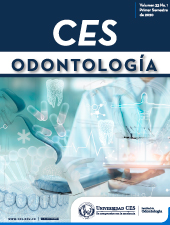Frequency of impacted third molar positions in patients treated in the IPS CES-Sabaneta-Antioquia
DOI:
https://doi.org/10.21615/cesodon.33.1.3Keywords:
Third Molars, Horizontal Position, Vertical PositionAbstract
Introduction and objective: The Impaction of third molars is a very common clinical situation in the world population; Pell & Gregory have suggested a classification for impaction based on horizontal and vertical position. To identify the frequency of impacted third molar positions in patients treated at the CES-Sabaneta clinic between the years 2006-2016. Materials and methods: According to the oral surgery service database, two examiners during 3 months reviewed 626 clinical histories in patients between 17 and 28 years of ages who had complete dental formula, with panoramic radiography and who were remitted for reasons orthodontic, restorative or surgical. Results: A total of 515 third molars were evaluated, the third most impacted molar was 28 (25.6%), followed by 18 (25.4%), 48 with 24.6% and 38 with 24.2%. %. The female gender prevailed with 58.6%. The most impacted tooth was 28 (87.8%). At the vertical level, position C was the most impacted, while in men the most impacted tooth is 18 with a 79.7. %, position B was the most impacted and at the horizontal level class II was the most common in both sex. Conclusions: At the vertical level, position B was the most frequent in the third molars of the female gender, however in the male gender there was a variation, in the maxillary the position C predominated; A horizontal level class II was the most frequent positions in both sex.
Downloads
References
Juodzbalys G, Daugela P. Mandibular Third Molar Impaction: Review of Literature and a Proposal of a Classification. J Oral Maxillofac Res. 2013;4(2). 12p.
Kay LW, Killey HC. The extraction of teeth. The impacted third molar. Dent Update. 1976;3(2):49-52p.
Hashemipour MA, Tahmasbi-Arashlow M, Fahimi-Hanzaei F. Incidence of impacted mandibular and maxillary third molars: a radiographic study in a Southeast Iran population. Med Oral Patol Oral Cir Bucal. 2013;18(1):e140-145p.
Bishara SE, Ortho D. Impacted maxillary canines: A review. Am J Orthod Dentofacial Orthop. 1992;101(2):159-171p.
Quek SL, Tay CK, Tay KH, Toh SL, Lim KC. Pattern of third molar impaction in a Singapore Chinese population: a retrospective radiographic survey. Int J Oral Maxillofac Surg. 2003;32(5):548-552p.
kanneppady SK, Balamanikandasrinivasan, Kumaresan R, Sakri SB. A comparative study on radiographic analysis of impacted third molars among three ethnic groups of patients attending AIMST Dental Institute, Malaysia (PDF Download Available) [Internet]. ResearchGate. 2015 [citado 7 de septiembre de 2017]. Disponible en: https://www.researchgate.net/publication/256482135_A_comparative_study_on_radiographic_analysis_of_impacted_third_molars_among_three_ethnic_groups_of_
patients_attending_AIMST_Dental_Institute_Malaysia ,2013: 13p.
Correa E,Pablo Emilio, Cotes P, Miguel Eduardo, Rosero O , Alba Patricia. Incidencia de dientes incluidos en 1184 Colombianos mayores de 17 años. [Bogota]; 1989, 158p.
Bishara SE, Andreasen G. Third molars: a review. - PubMed - NCBI. 1983;(Am J Orthod.):131-137p.
Grover PS, Lorton L. The incidence of unerupted permanent teeth and related clinical cases. - PubMed - NCBI. 1985 Apr. 59 (4)(Oral Surg Oral Med Oral Pathol):420-425p.
Bjork A. Prediction of mandibular growth rotation. - PubMed - NCBI. Am J Orthod Dentofac Ortho. 1969;55(6):585-599p.
Brown LH, Berkman S, Cohen D, Kaplan AL, Rosenberg M. A radiological study of the frequency and distribution of impacted teeth. - PubMed - NCBI. J Dent Associ Afr. 1982;37 (9):627-630p.
Hugoson A, Kugelberg CF. The prevalence of third molars in a Swedish population. An epidemiological study. - PubMed - NCBI. Conmunity Dent Health. 1988;5 (2):121-138p.
Macías, Hernández SI, González-Muñoz CG, Campo JO-M del, Morones-Alba JD. Efectos de la colágena-polivinilpirrolidona en la regeneración ósea posterior a la cirugía de terceros molares retenidos. Ensayo clínico controlado. Rev Asoc Dent Mex. 2014;71(6):280-284.
Ruchadaporn, kaomongkolgit, Weeraya Tantanpornkul. Pattern of impacted third molars in Thai population: Retrospective radiographic survey. 2017. 30-35p.
Ochoa Gonzalez GA, Upegui Jimenez LF, Orozco Zea JI. Analisis estadistico sobre terceros molares . Medellin: Universidad Ces; 1990. 77p.
Jose Nayib Radi Londoño, Jaime Alberto Vargas V. Aspectos claves tercer molar. Medellin: CIB fondo editorial; 2013. 24 p.
Breik O, Grubor D. The incidence of mandibular third molar impactions in different skeletal face types. - PubMed - NCBI. Aust Dent J. 2008;53 (4):320-324p.
Syed KB, Kota Z, Ibrahim M, Bagi MA, Assiri MA. Prevalence of Impacted Molar Teeth among Saudi Population in Asir Region, Saudi Arabia - A Retrospective Study of 3 Years. J Int Oral Health. 2013;5(1):43-47p.
Arabion H, Gholami M, Dehghan H, Khalife H. Prevalence of Impacted Teeth among Young Adults: A Retrospective Radiographic Study. J Dent Mater Tech. 2017;6(3):131-137p.
Salmen FS, Oliveira MR, Gabrielli MAC, Piveta ACG, Pereira-Filho VA, Gabrielli MFR, et al. Third molar extractions: a retrospective study of 1178 cases. RGO - Rev Gaúcha Odontol. 2016;64(3):250-255p.
Downloads
Published
How to Cite
Issue
Section
License
Copyright (c) 2020 CES Odontología

This work is licensed under a Creative Commons Attribution-NonCommercial-ShareAlike 4.0 International License.
| Article metrics | |
|---|---|
| Abstract views | |
| Galley vies | |
| PDF Views | |
| HTML views | |
| Other views | |



